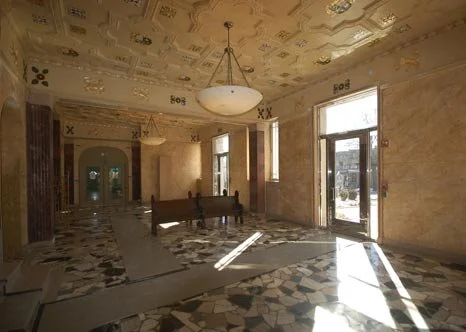Case Studies
The Metropolitan Apartments, Washington, DC
Overview:
Built between 1936 and 1937 and located one mile north of the U.S. Capitol building, the Metropolitan Apartments houses just over 160 apartments in the rejuvenated Edgewood neighborhood of Washington, DC. In 2011, MT Properties acquired the property with the intention of restoring it to its historic stateliness.
Lobby of the Metropolitan.
Challenge:
After the original owners sold the Metropolitan in the mid-1960s, the building fell into disrepair. When the current owners acquired the property, they sought to reveal the Metropolitan’s 1930s architecture while providing modern infrastructure and amenities. The apartments are laid out along central hallways that feature terrazzo floors and textured plaster walls and ceilings. The Metropolitan is noted for its historic design and its main lobby, which retains its original configuration and most of its interior finishes, including matching east and west wing marble stairs, a mosaic tile floor, square-edged marble baseboards, and walls clad in Venetian plaster and scagliola pilasters throughout the room. The historic restoration would be more expensive than simply demolishing the historic interiors and starting over.
Though the Metropolitan was designed by George Santmyers, DC’s most prolific architect, and commissioned by Abraham S. Kay, an influential builder and philanthropist, it had not been listed on the DC Inventory of Historic Sites or the National Register of Historic Places. Without such recognition, the new owners could not receive historic preservation tax credits for the revitalization of the building that they wanted to undertake. They consulted History Matters to evaluate if the Metropolitan could be listed on the DC and the National Register.
Solution:
History Matters researched the Metropolitan’s history and evaluated the integrity of its architecture to determine if it qualified for historic recognition. We wrote a successful National Register nomination and gained approval for its listing as a DC Landmark. We represented the owners at hearings before the DC Historic Preservation Board. After these approvals, we then shepherded the owners through the National Park Service historic preservation tax credit process in order for them to obtain 20 percent of the Metropolitan’s total rehabilitation costs.
Result:
History Matters helped the Metropolitan’s owners navigate interactions with the DC HPO, the DC Historic Preservation Review Board, and the National Park Service. The Metropolitan is now recognized as part of the DC Inventory of Historic Sites and the National Register of Historic Places. With this recognition in place, the owners sought and received approval for historic preservation tax credits and Washington, DC obtained revitalized historic housing.
Contact us
Interested in working together? Fill out some info and we will be in touch shortly.


